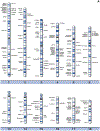Clinically relevant genetic biomarkers from the brain in alcoholism with representation on high resolution chromosome ideograms
- PMID: 25655461
- PMCID: PMC6675570
- DOI: 10.1016/j.gene.2015.01.064
Clinically relevant genetic biomarkers from the brain in alcoholism with representation on high resolution chromosome ideograms
Abstract
Objective: Alcoholism arises from combined effects of multiple biological factors including genetic and non-genetic causes with gene/environmental interaction. Intensive research and advanced genetic technology has generated a long list of genes and biomarkers involved in alcoholism neuropathology. These markers reflect complex overlapping and competing effects of possibly hundreds of genes which impact brain structure, function, biochemical alcohol processing, sensitivity and risk for dependence.
Method: We compiled a tabular list of clinically relevant genetic biomarkers for alcoholism targeting expression disturbances in the human brain through an extensive search of keywords related to alcoholism, alcohol abuse, and genetics from peer reviewed medical research articles and related nationally sponsored websites. Gene symbols were then placed on high resolution human chromosome ideograms with gene descriptions in tabular form.
Results: We identified 337 clinically relevant genetic biomarkers and candidate genes for alcoholism and alcohol-responsiveness from human brain research. Genetic biomarkers included neurotransmitter pathways associated with brain reward processes for dopaminergic (e.g., DRD2, MAOA, and COMT), serotoninergic (e.g., HTR3A, HTR1B, HTR3B, and SLC6A4), GABAergic (e.g., GABRA1, GABRA2, and GABRG1), glutaminergic (GAD1, GRIK3, and GRIN2C) and opioid (e.g., OPRM1, OPRD1, and OPRK1) pathways which presumably impact reinforcing properties of alcohol. Gene level disturbances in cellular and molecular networks impacted by alcohol and alcoholism pathology include transketolase (TKT), transferrin (TF), and myelin (e.g., MBP, MOBP, and MOG).
Conclusions: High resolution chromosome ideograms provide investigators, physicians, geneticists and counselors a convenient visual image of the distribution of alcoholism genetic biomarkers from brain research with alphabetical listing of genes in tabular form allowing comparison between alcoholism-related phenotypes, and clinically-relevant alcoholism gene(s) at the chromosome band level to guide research, diagnosis, and treatment. Chromosome ideograms may facilitate gene-based personalized counseling of alcohol dependent individuals and their families.
Keywords: Alcoholism; Brain; Chromosome band location; Gene; Genetic biomarkers; High resolution chromosome ideograms.
Copyright © 2015 Elsevier B.V. All rights reserved.
Figures


Similar articles
-
Currently recognized genes for schizophrenia: High-resolution chromosome ideogram representation.Am J Med Genet B Neuropsychiatr Genet. 2016 Mar;171B(2):181-202. doi: 10.1002/ajmg.b.32391. Epub 2015 Oct 13. Am J Med Genet B Neuropsychiatr Genet. 2016. PMID: 26462458 Free PMC article.
-
Currently recognized clinically relevant and known genes for human reproduction and related infertility with representation on high-resolution chromosome ideograms.Gene. 2016 Jan 1;575(1):149-59. doi: 10.1016/j.gene.2015.08.057. Epub 2015 Sep 2. Gene. 2016. PMID: 26341055 Free PMC article. Review.
-
High-resolution chromosome ideogram representation of recognized genes for bipolar disorder.Gene. 2016 Jul 15;586(1):136-47. doi: 10.1016/j.gene.2016.04.011. Epub 2016 Apr 7. Gene. 2016. PMID: 27063557 Free PMC article.
-
High-resolution chromosome ideogram representation of currently recognized genes for autism spectrum disorders.Int J Mol Sci. 2015 Mar 20;16(3):6464-95. doi: 10.3390/ijms16036464. Int J Mol Sci. 2015. PMID: 25803107 Free PMC article.
-
Clinically relevant known and candidate genes for obesity and their overlap with human infertility and reproduction.J Assist Reprod Genet. 2015 Apr;32(4):495-508. doi: 10.1007/s10815-014-0411-0. Epub 2015 Jan 29. J Assist Reprod Genet. 2015. PMID: 25631154 Free PMC article. Review.
Cited by
-
A Genetic Animal Model of Alcoholism for Screening Medications to Treat Addiction.Int Rev Neurobiol. 2016;126:179-261. doi: 10.1016/bs.irn.2016.02.017. Epub 2016 Mar 21. Int Rev Neurobiol. 2016. PMID: 27055615 Free PMC article. Review.
-
Bibliometric Insights in Genetic Factors of Substance-Related Disorders: Intellectual Developments, Turning Points, and Emerging Trends.Front Psychiatry. 2021 May 31;12:620489. doi: 10.3389/fpsyt.2021.620489. eCollection 2021. Front Psychiatry. 2021. PMID: 34135780 Free PMC article.
-
GABBR1 and SLC6A1, Two Genes Involved in Modulation of GABA Synaptic Transmission, Influence Risk for Alcoholism: Results from Three Ethnically Diverse Populations.Alcohol Clin Exp Res. 2016 Jan;40(1):93-101. doi: 10.1111/acer.12929. Alcohol Clin Exp Res. 2016. PMID: 26727527 Free PMC article.
-
The genetic epidemiology of substance use disorder: A review.Drug Alcohol Depend. 2017 Nov 1;180:241-259. doi: 10.1016/j.drugalcdep.2017.06.040. Epub 2017 Aug 1. Drug Alcohol Depend. 2017. PMID: 28938182 Free PMC article. Review.
-
Morphopathological approaches in alcoholism.Rom J Morphol Embryol. 2020 Apr-Jun;61(2):345-351. doi: 10.47162/RJME.61.2.04. Rom J Morphol Embryol. 2020. PMID: 33544786 Free PMC article.
References
-
- Agrawal A, Edenberg HJ, Foroud T, Bierut LJ, Dunne G, Hinrichs AL, Nurnberger JI, Crowe R, Kuperman S, Schuckit MA, Begleiter H, Porjesz B, Dick DM, 2006. Association of GABRA2 with drug dependence in the collaborative study of the genetics of alcoholism sample. Behav. Genet 36, 640–665. - PubMed
-
- Bierut LJ, Dinwiddie SH, Begleiter H, Crowe RR, Hesselbrock V, Nurnberger JI Jr., Porjesz B, Schuckit MA, Reich T, 1998. Familial transmission of substance dependence: alcohol, marijuana, cocaine, and habitual smoking: a report from the Collaborative Study on the Genetics of Alcoholism. Arch. Gen. Psychiatry 55, 982–988 (Erratum in: Arch Gen Psychiatry 2002 59, 153). - PubMed
-
- Bierut LJ, Agrawal A, Bucholz KK, Doheny KF, Laurie C, Pugh E, Fisher S, Fox L, Howells W, Bertelsen S, Hinrichs AL, Almasy L, Breslau N, Culverhouse RC, Dick DM, Edenberg HJ, Foroud T, Grucza RA, Hatsukami D, Hesselbrock V, Johnson EO, Kramer J, Krueger RF, Kuperman S, Lynskey M, Mann K, Neuman RJ, Nöthen MM, Nurnberger JI Jr., Porjesz B, Ridinger M, Saccone NL, Saccone SF, Schuckit MA, Tischfield JA, Wang JC, Rietschel M, Goate AM, Rice JP, 2010. A genome-wide association study of alcohol dependence. Proc. Natl. Acad. Sci. U. S. A 107 (11), 5082–5087. - PMC - PubMed
-
- Blum K, Noble EP, Sheridan PJ, Montgomery A, Ritchie T, Jagadeeswaran P, Nogami H, Briggs AH, Cohn JB, 1990. Allelic association of human dopamine D(2) receptor gene in alcoholism. J. Am. Med. Assoc 263, 2055–2060. - PubMed
Publication types
MeSH terms
Substances
Grants and funding
LinkOut - more resources
Full Text Sources
Other Literature Sources
Medical
Miscellaneous

